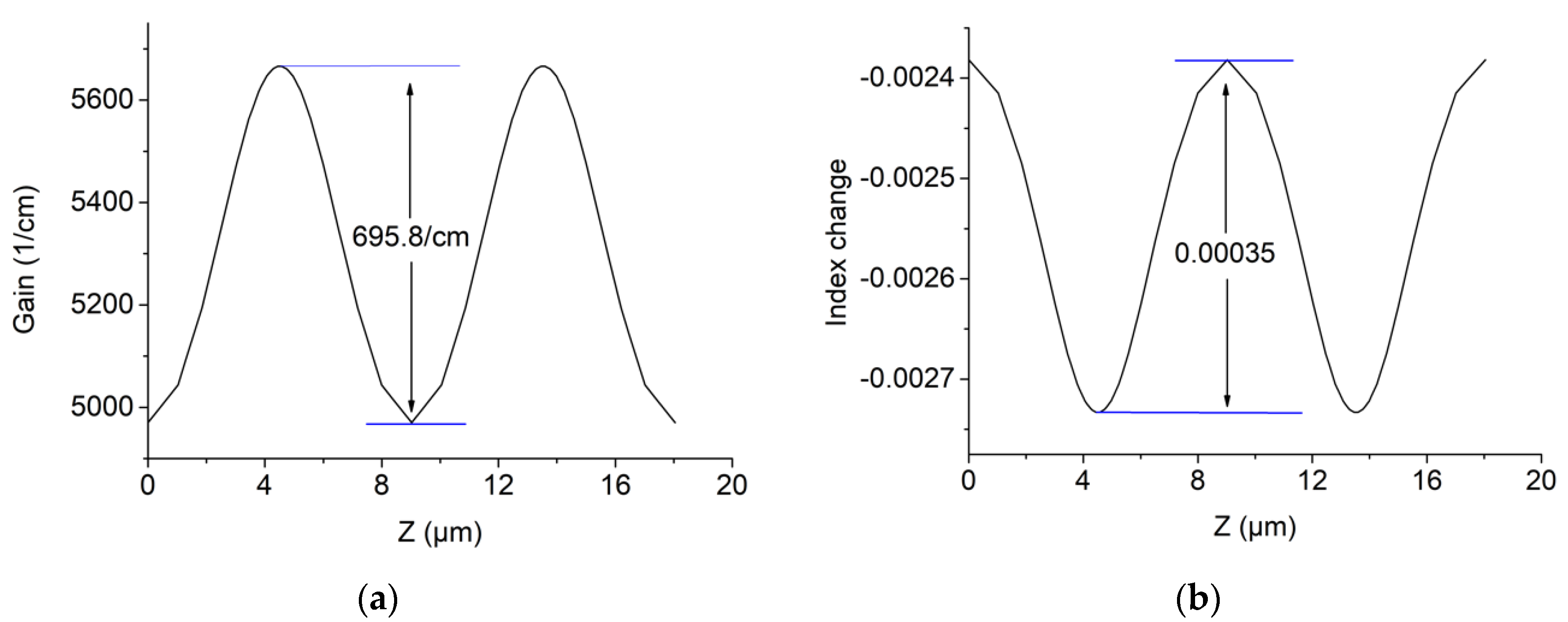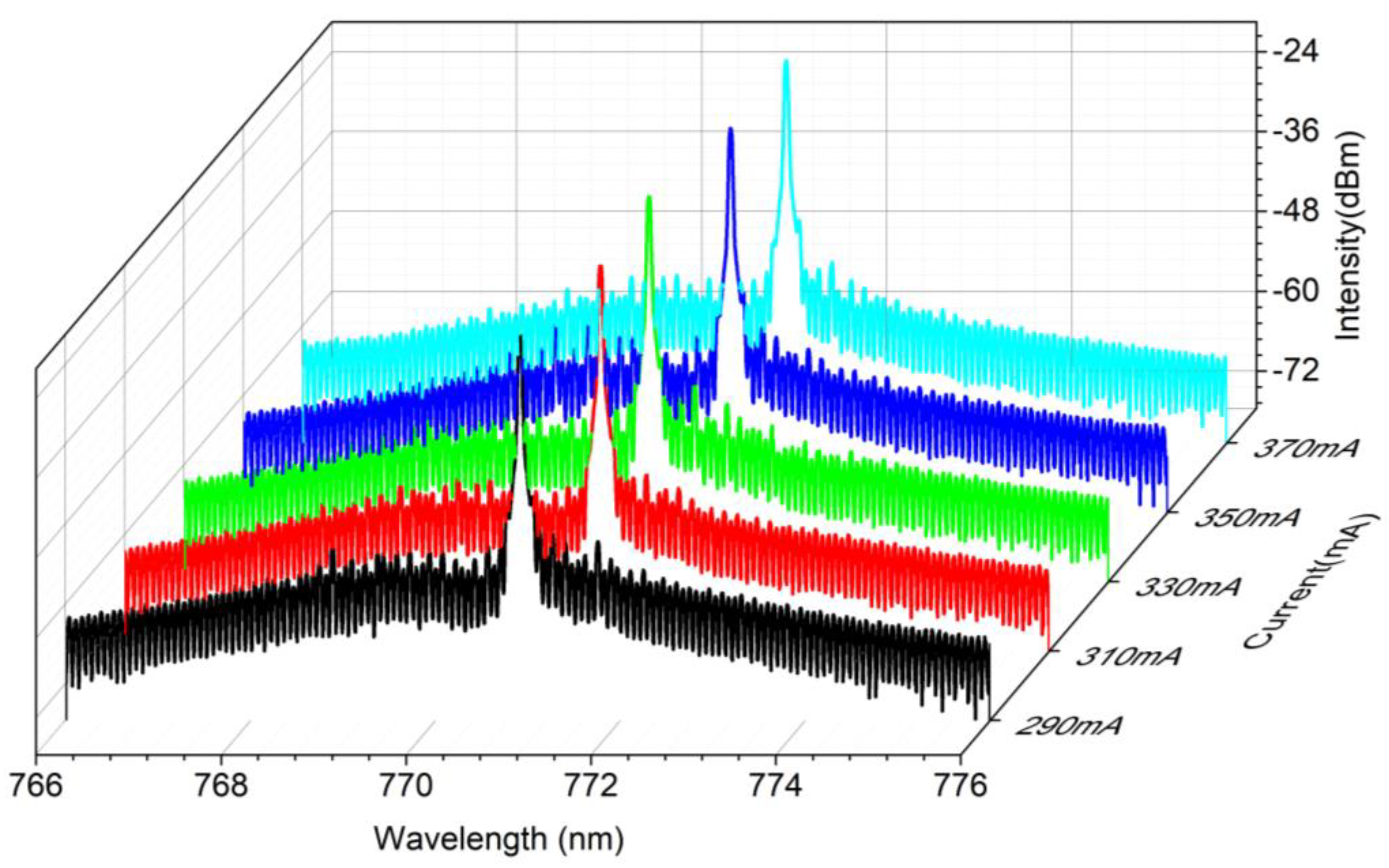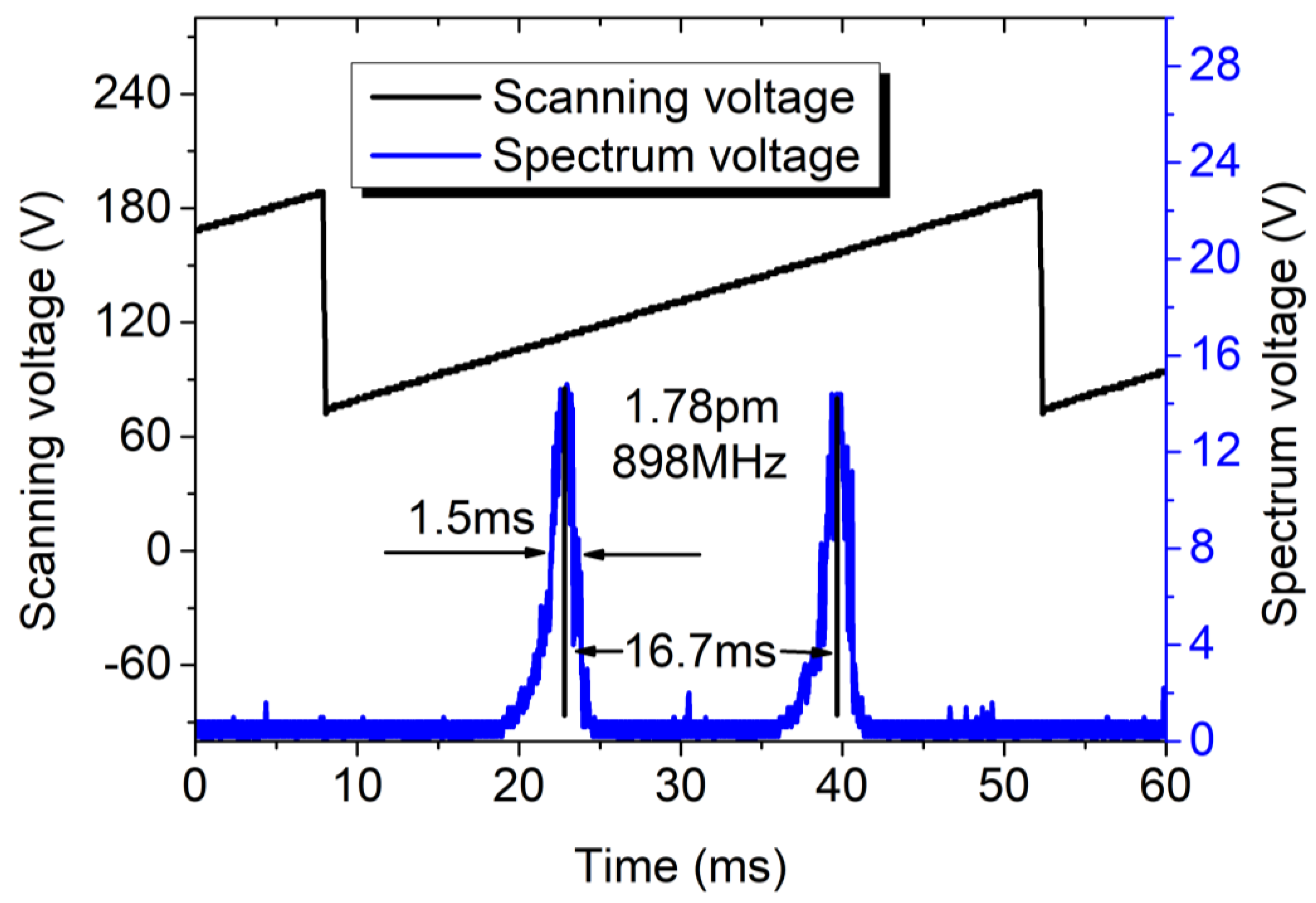Purely Gain-Coupled Distributed-Feedback Bragg Semiconductor Laser Diode Emitting at 770 nm
Abstract
:1. Introduction
2. Materials and Methods
3. Results and Discussion
4. Conclusions
Author Contributions
Funding
Institutional Review Board Statement
Informed Consent Statement
Data Availability Statement
Acknowledgments
Conflicts of Interest
References
- Kanskar, M.; Cai, J.; Galstad, C.; He, Y.; Macomber, S.H.; Stiers, E.; Tatavarti-Bharatam, S.R.; Botez, D.; Mawst, J.L. High power conversion efficiency and wavelength-stabilized narrow bandwidth 975nm diode laser pumps. In Proceedings of the SPIE—The International Society for Optical Engineering, Orlando, FL, USA, 12 May 2006. [Google Scholar]
- Crump, P.; Schultz, C.M.; Wenzel, H.; Knigge, S.; Brox, O.; Maaßdorf, A.; Bugge, F.; Erbert, G. Reliable Operation of 976nm High Power DFB Broad Area Diode Lasers with over 60% POWER Conversion Efficiency. In Novel In-Plane Semiconductor Lasers X; International Society for Optics and Photonics: Bellingham, WA, USA, 2011. [Google Scholar]
- Spiebberger, S.; Schiemangk, M.; Wicht, A.; Wenzel, H.; Brox, O.; Erbert, G. Narrow Linewidth DFB Lasers Emitting Near a Wavelength of 1064 nm. J. Lightwave Technol. 2010, 28, 2611–2616. [Google Scholar] [CrossRef]
- Dridi, K.; Benhsaien, A.; Zhang, J.; Hinzer, K.; Hall, T.J. Narrow linewidth two-electrode 1560 nm laterally coupled distributed feedback lasers with third-order surface etched gratings. Opt. Express 2014, 22, 19087–19097. [Google Scholar] [CrossRef]
- Li, L.; Tang, S.; Huang, L.; Zhang, T.; Li, S.; Shi, Y.; Chen, X. Experimental demonstration of a low-cost tunable semiconductor DFB laser for access networks. Semicond. Ence Technol. 2014, 29, 095002. [Google Scholar] [CrossRef]
- Tilma, B.W.; Mangold, M.; Zaugg, C.A.; Link, S.M.; Waldburger, D.; Klenner, A.; Mayer, A.S.; Gini, E.; Golling, M.; Keller, U. Recent advances in ultrafast semiconductor disk lasers. Light Sci. Appl. 2015, 4, e310. [Google Scholar] [CrossRef] [Green Version]
- Zheng, J.; Shi, Y.; Zhang, Y.; Zheng, J.; Lu, J.; Chen, X. Monolithically Integrated Four-Channel DFB Semiconductor Laser Array With an Equivalent-Distributed Coupling Coefficient. IEEE Photonics J. 2015, 7, 1. [Google Scholar] [CrossRef]
- Nehrir, R.; Repasky, K.S.; Carlsten, J.L. Eye-safe diode-laser-based micropulse differential absorption lidar (DIAL) for water vapor profiling in the lower troposphere. J. Atmos. Ocean. Technol. 2011, 28, 131–147. [Google Scholar] [CrossRef]
- Kowalczyk, M.; Sotor, J.; Abramski, K.M. 59 fs mode-locked Yb:KGW oscillator pumped by a single-mode laser diode. Laser Phys. Lett. 2016, 13, 035801. [Google Scholar] [CrossRef] [Green Version]
- Noda, C.Q.; Uitenbroek, H.; Katsukawa, Y.; Shimizu, T.; Oba, T.; Carlsson, M.; Suárez, D.O.; Cobo, B.R.; Kubo, M.; Anan, T.; et al. Solar polarimetry through the KI lines at 770 nm. Mon. Not. R. Astron. Soc. 2018, 470, 1453–1461. [Google Scholar] [CrossRef] [Green Version]
- Brookes, J.R.; Isaak, G.R.; Van der Raay, H.B. A resonant-scattering solar spectrometer. Mon. Not. R. Astron. Soc. 1978, 185, 1–18. [Google Scholar] [CrossRef] [Green Version]
- Bruls, J.H.M.J.; Rutten, R.J. The formation of helioseismology lines. II—Modeling of alkali resonance lines with granulation. Astron. Astrophys. 1992, 265, 257–267. [Google Scholar]
- Brox, O.; Bugge, F.; Mogilatenko, A.; Luvsandamdin, E.; Wicht, A.; Wenzel, H.; Erbert, G. Distributed feedback lasers in the 760 to 810 nm range and epitaxial grating design. Semicond. Sci. Technol. 2014, 29, 095018. [Google Scholar]
- Serkland, D.K.; Geib, K.M.; Peake, G.M.; Lutwak, R.; Rashed, A.; Varghese, M.; Tepolt, G.; Prouty, M. VCSELs for atomic sensors. In Proceedings of the SPIE—The International Society for Optical Engineering, San Jose, CA, USA, 23 February 2007. [Google Scholar]
- Nakano, Y.; Luo, Y.; Tada, K. AlGaAs/GaAs visible distributed feedback laser operating at 770 nm. Electron. Lett. 1987, 23, 1342–1343. [Google Scholar] [CrossRef]
- Krysa, A.B.; Roberts, J.S.; Devenson, J.; Beanland, R.; Karomi, I.; Shutts, S.; Smowton, P.M. InAsP/AlGaInP/GaAs QD laser operating at ~770 nm. In Proceedings of the International Symposium on Coherent Optical Radiation of Semiconductor Compounds and Structures, Moscow, Russia, 23–26 November 2016. [Google Scholar]
- Reinhold, A.; Fischer, M.; Zeller, W.; Koeth, J.; Höfling, S.; Kamp, M. Evanescently Coupled DBR Laser Arrays in the 760–770 nm Wavelength Range. IEEE Photonics Technol. Lett. 2019, 31, 1319–1322. [Google Scholar] [CrossRef] [Green Version]
- Nechay, K.; Kahle, H.; Penttinen, J.P.; Rajala, P.; Tukiainen, A.; Ranta, S.; Guina, M. AlGaAs/AlGaInP VECSELs With Direct Emission at 740–770 nm. IEEE Photonics Technol. Lett. 2019, 31, 1245–1248. [Google Scholar] [CrossRef]
- Kogelnik, H.; Shank, C.V. Coupled-wave theory of distributed feedback lasers. J. Appl. Phys. 1972, 43, 2327–2335. [Google Scholar] [CrossRef]
- Zuo, Q.; Zhao, J.Y.; Chen, X.; Wang, Z.H.; Sun, T.Y.; Zhou, N.; Zhao, Y.-L.; Xu, Z.-M.; Liu, W. A Multiple Phase-Shifted Distributed Feedback (DFB) Laser Fabricated by Nanoimprint Lithography. Chin. Phys. Lett. 2013, 30. [Google Scholar] [CrossRef]
- Zhang, L.M.; Carroll, J.E. Dynamics of index coupled DFB lasers with minimal spatial hole burning. IEEE Photonics Technol. Lett. 2002, 6, 486–488. [Google Scholar] [CrossRef]
- Correc, P. Stability of phase-shifted DFB lasers against hole burning. IEEE J. Quantum Electron. 2002, 30, 2467–2476. [Google Scholar] [CrossRef]
- Ogita, S.; Kotaki, Y.; Matsuda, M.; Kuwahara, Y.; Ishikawa, H. Long cavity multiple-phase-shift distributed feedback laser for linewidth narrowing. Electron. Lett. 1989, 25, 629–630. [Google Scholar] [CrossRef]
- Okai, M.; Tsuchiya, T.; Uomi, K.; Chinone, N.; Harada, T. Corrugation-pitch modulated MQW-DFB lasers with narrow spectral linewidth. IEEE Photonics Technol. Lett. 1991, 27, 1767–1772. [Google Scholar] [CrossRef]
- Shi, Y.; Li, S.; Li, J.; Jia, L.; Liu, S.; Chen, X. An apodized DFB semiconductor laser realized by varying duty cycle of sampling Bragg grating and reconstruction-equivalent-chirp technology. Optics Commun. 2010, 283, 1840–1844. [Google Scholar] [CrossRef]
- Li, G.P.; Makino, T. Single-mode yield analysis of partly gain-coupled multiquantum-well DFB lasers. IEEE Photonics Technol. Lett. 1993, 5, 1282–1284. [Google Scholar] [CrossRef]
- Nakano, Y.; Luo, Y.; Tada, K. Facet reflection independent, single longitudinal mode oscillation in a GaAlAs/GaAs distributed feedback laser equipped with a gain-coupling mechanism. Appl. Phys. Lett. 1989, 55, 1606–1608. [Google Scholar] [CrossRef]
- Luo, Y.; Nakano, Y.; Tada, K.; Inoue, T.; Hosomatsu, H.; Iwaoka, H. Purely gain-coupled distributed feedback semiconductor lasers. Appl. Phys. Lett. 1990, 56, 1620–1622. [Google Scholar] [CrossRef]
- Chen, Y.; Jia, P.; Zhang, J.; Qin, L.; Chen, H.; Gao, F.; Zhang, X.; Shan, X.; Ning, Y.; Wang, L. Gain-coupled distributed feedback laser based on periodic surface anode canals. Appl. Opt. 2015, 54, 8863. [Google Scholar] [CrossRef] [PubMed]
- Gao, F.; Qin, L.; Chen, Y.; Jia, P.; Chen, C.; Cheng, L.; Chen, H.; Liang, L.; Zeng, Y.; Zhang, X.; et al. Study of gain-coupled distributed feedback laser based on high order surface gain-coupled gratings. Opt. Commun. 2018, 410, 936–940. [Google Scholar] [CrossRef]
- Available online: http://www.photodigm.com/products/770-nm-laser-diode (accessed on 20 January 2021).
- Stry, S.; Thelen, S.; Sacher, J.; Halmer, D.; Hering, P.; Mürtz, M. Widely tunable diffraction limited 1000 mW external cavity diode laser in Littman/Metcalf configuration for cavity ring-down spectroscopy. Appl. Phys. B 2006, 85, 365–374. [Google Scholar] [CrossRef]
- Ito, F.; Tanifuji, T. Carrier-injection-type optical switch in GaAs with a 1.06–1.55 μm wavelength range. Appl. Phys. Lett. 1989, 54, 134–136. [Google Scholar] [CrossRef]
- Wang, B. Reseach on All Optical Solid-state X-ray Detection with Picosecond Resolusion Based on Refractive Index Modulation. Ph.D. Thesis, University of Chinese Academy of Sciences, Bejing, China, 2016. [Google Scholar]
- David, K.; Morthier, G. Gain-coupled DFB lasers versus index-coupled and phase-shifted DFB lasers: A comparison based on spatial hole burning corrected yield. IEEE J. Quantum Electron. 1991, 27, 1714–1723. [Google Scholar] [CrossRef]
- Decker, J.; Crump, P.; Fricke, J.; Maassdorf, A.; Erbert, G.; Trankle, G. Narrow Stripe Broad Area Lasers With High Order Distributed Feedback Surface Gratings. IEEE Photonics Technol. Lett. 2014, 26, 829–832. [Google Scholar] [CrossRef]
- Virtanen, H.; Uusitalo, T.; Karjalainen, M.; Ranta, S.; Viheriälä, J.; Dumitrescu, M. Narrow-Linewidth 780-nm DFB Lasers Fabricated Using Nanoimprint Lithography. IEEE Photonics Technol. Lett. 2017, 30, 51–54. [Google Scholar] [CrossRef]






| Material | Structure | Thickness (μm) | Dopant |
|---|---|---|---|
| GaAs | Cap | 0.1 | Carbon |
| Al(x)GaAs | P-cladding | 0.8 | Carbon |
| Al(x)GaAs | P-wave guide | 0.4 | Carbon |
| Al(x)In(y)GaAs | Quantum well | 0.0055 | Undoped |
| Al(x)GaAs | N-wave guide | 1 | Silicon |
| Al(x)GaAs | N-cladding | 1.5 | Silicon |
| GaAs | Buffer | 0.5 | Silicon |
Publisher’s Note: MDPI stays neutral with regard to jurisdictional claims in published maps and institutional affiliations. |
© 2021 by the authors. Licensee MDPI, Basel, Switzerland. This article is an open access article distributed under the terms and conditions of the Creative Commons Attribution (CC BY) license (http://creativecommons.org/licenses/by/4.0/).
Share and Cite
Ruan, C.; Chen, Y.; Qin, L.; Jia, P.; Zeng, Y.; Song, Y.; Lei, Y.; Zhang, Z.; Zhang, N.; Li, Z. Purely Gain-Coupled Distributed-Feedback Bragg Semiconductor Laser Diode Emitting at 770 nm. Appl. Sci. 2021, 11, 1531. https://doi.org/10.3390/app11041531
Ruan C, Chen Y, Qin L, Jia P, Zeng Y, Song Y, Lei Y, Zhang Z, Zhang N, Li Z. Purely Gain-Coupled Distributed-Feedback Bragg Semiconductor Laser Diode Emitting at 770 nm. Applied Sciences. 2021; 11(4):1531. https://doi.org/10.3390/app11041531
Chicago/Turabian StyleRuan, Chunkao, Yongyi Chen, Li Qin, Peng Jia, Yugang Zeng, Yue Song, Yuxin Lei, Zhijun Zhang, Nan Zhang, and Zaijin Li. 2021. "Purely Gain-Coupled Distributed-Feedback Bragg Semiconductor Laser Diode Emitting at 770 nm" Applied Sciences 11, no. 4: 1531. https://doi.org/10.3390/app11041531





